
The University of Winnipeg is a public research university in Winnipeg,Manitoba,Canada. It offers undergraduate programs in art,business,economics,education,science and applied health as well as graduate programs. UWinnipeg's founding colleges were Manitoba College and Wesley College,which merged to form United College in 1938. The University of Winnipeg was established in 1967 when United College received its charter.
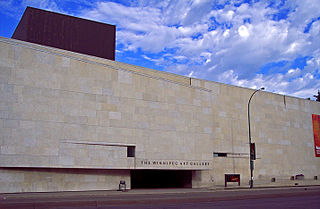
The Winnipeg Art Gallery (WAG) is an art museum in Winnipeg,Manitoba,Canada. Its permanent collection includes over 24,000 works from Canadian,Indigenous Canadian,and international artists. The museum also holds the world's largest collection of Inuit art. In addition to exhibits for its collection,the museum has organized and hosted a number of travelling arts exhibitions. Its building complex consists of a main building that includes 11,000 square metres (120,000 sq ft) of indoor space and the adjacent 3,700-square-metre (40,000 sq ft) Qaumajuq building.
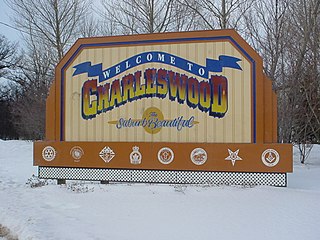
Charleswood is a residential community and neighbourhood in Winnipeg,Manitoba,Canada. Situated in the southwest of the city,it is bordered by the neighbourhoods of Tuxedo to the east,Whyte Ridge to the south,and the Rural Municipality of Headingley to the west. The area's boundaries are defined by Roblin Boulevard and the Assiniboine River to the north,Shaftesbury Boulevard to the east,Wilkes Avenue to the south,and the Perimeter Highway to the west.
The Winnipeg City Council is the governing body of the city of Winnipeg,Manitoba,Canada. The Council is seated in the Council Building of Winnipeg City Hall.

The Manitoba Museum,previously the Manitoba Museum of Man and Nature,is a human and natural history museum in Winnipeg,Manitoba,as well as the province's largest,not-for-profit centre for heritage and science education.
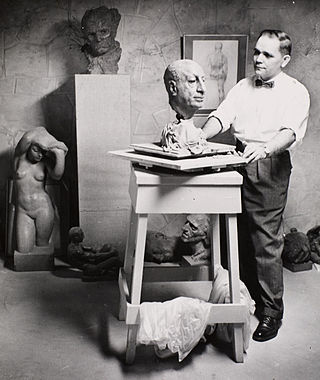
Leonid Molodozhanyn,known as Leo Mol,was a Ukrainian Canadian stained glass artist,painter and sculptor.

The Manitoba Legislative Building,originally named the Manitoba Parliament Building,is the meeting place of the Legislative Assembly of Manitoba,located in central Winnipeg,as well as being the twelfth provincial heritage site of Manitoba. Along with the Legislative Assembly,the building also accommodates the offices for Manitoba's Lieutenant Governor and the Executive Council.
Academy Road is a street in Winnipeg,Manitoba,Canada. It runs from the Maryland Bridge to Wellington Crescent,just west of Route 90,and actually intersects with Wellington at both its east and west ends. Academy Road is located in the residential neighbourhood of River Heights and has many retail stores along it.
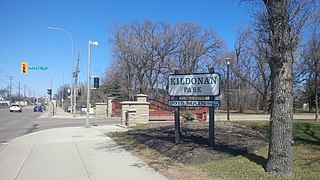
Kildonan Park is a park in the West Kildonan area of northern Winnipeg,Manitoba,Canada.

Assiniboine Park is a park in Winnipeg,Manitoba,Canada,located along the Assiniboine River.

Winnipeg Beach is a town in the Interlake Region,in the Canadian province of Manitoba. The town was founded in 1900 by Sir William Whyte and is located at the junction of Highway 9 and Highway 229 on the southwestern shore of Lake Winnipeg,about 56 kilometres (35 mi) north of Winnipeg. It is bordered by the Rural Municipality of Gimli,the Rural Municipality of St. Andrews,and Dunnottar as well as Lake Winnipeg. Nearby towns are Ponemah,Whytewold,and Matlock,Gimli,and Sandy Hook,,as well as Teulon,and Selkirk. Its permanent population is 1,439

Downtown Winnipeg is an area of Winnipeg located near the confluence of the Red and Assiniboine rivers. It is the oldest urban area in Winnipeg,and is home to the city's commercial core,city hall,the seat of Manitoba's provincial government,and a number of major attractions and institutions.

The Forks is a historic site,meeting place,and green space in downtown Winnipeg located at the confluence of the Red River and the Assiniboine River.
Manitoba Centennial Centre is an arts and cultural district that covers a 34-acre area in the east Exchange District of the Point Douglas area in Winnipeg,Manitoba,linking several of Manitoba's important arts and cultural facilities.

Assiniboine Park Zoo is a Canadian zoo facility located in the west end of Assiniboine Park in Winnipeg,Manitoba,Canada. Established in 1904,Assiniboine Park Zoo is managed by the Assiniboine Park Conservancy. It holds accreditation from the Canadian Association of Zoos and Aquariums and the Association of Zoos and Aquariums.

Ivan Kenneth Eyre was a Canadian artist best known for his prairie landscapes and compositionally abstract,figurative paintings. In addition,Eyre was a Professor Emeritus of painting and drawing at the University of Manitoba where he taught for 33 years,from 1959 until his retirement in 1992. He has been described as a "visual philosopher" and "a true outsider and visionary".

Central Park is a large urban park located in downtown Winnipeg,and forms the heart of the neighbourhood of the same name.
This is a timeline of the history of Winnipeg.
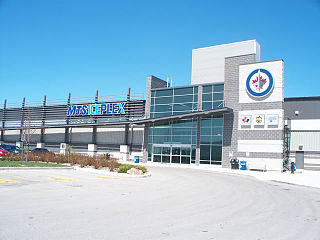
Hockey for All Centre is an ice hockey facility in Winnipeg,Manitoba,near the Red River Exhibition.

The Cornish Library,is a branch of the Winnipeg Public Library,located in Winnipeg,Manitoba,Canada. Like the St. John's Library,the Cornish is one of two Carnegie libraries in the city. It is a Grade II listed building and a Winnipeg Landmark Heritage Structure. It was gazetted on January 15,1993. It is named in honour of Winnipeg's first mayor,Francis Evans Cornish.


















